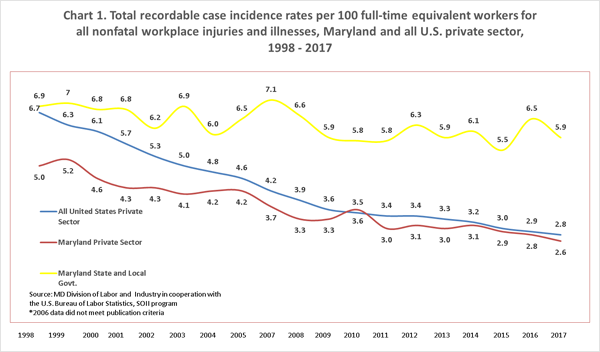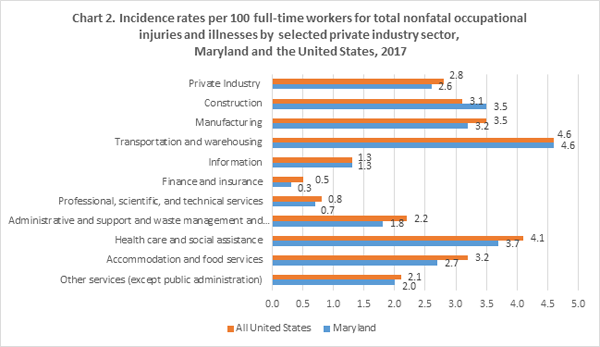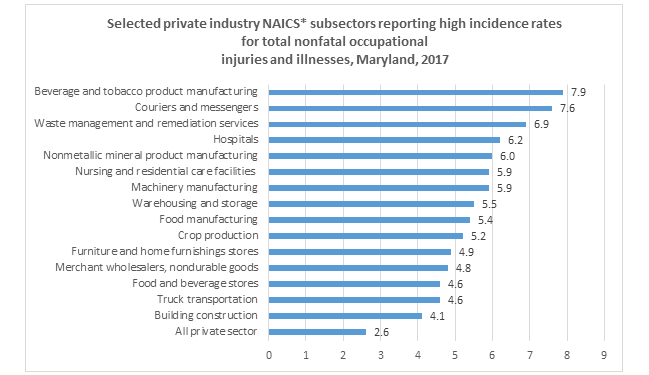Research and Statistics - Maryland Occupational Safety and Health (MOSH)
In 2017, approximately 62,600 nonfatal workplace injuries and illnesses were reported through the Bureau of Labor Statistics’ Survey of Occupational Injuries and Illnesses by Maryland’s private sector and State and local government employers. The injuries and illnesses occurred at a rate of 3.0 cases per 100 full-time equivalent workers. This rate represented a 9 percent decline from the previous year‘s rate of 3.3 per 100 full-time equivalent workers. The Survey of Occupational Injuries and Illnesses or (SOII) is a cooperative program between the Maryland Department of Labor, Licensing and Regulation, Division of Labor and Industry and the U.S. Department of Labor, Bureau of Labor Statistics. In 2017 there were approximately 2.5 million workers in the State under the Maryland Occupational Safety and Health (MOSH) agency’s regulatory oversight.1
Maryland’s Private Sector
Maryland’s private sector employers reported 46,600 nonfatal injuries and illnesses for 2017 compared to 48,400 reported in 2016. Injuries and illnesses in private industry occurred at a rate of 2.6 cases per 100 equivalent full-time workers. Approximately 96.6 percent of all cases reported in private industry were injuries while the remainder were occupational illnesses. Cases of a more serious nature involving days away from work, job transfers, or restrictions -- commonly referred to as the DART rate, occurred at a rate of 1.5 cases per 100 full-time equivalent workers. There were 27,900 such cases reported.
Rates of injury and illness by industry sector ranged from a total recordable case incidence rate of 0.2 injuries and illnesses per 100 full-time equivalent workers for Management of companies and enterprises (NAICS 55) to a rate of 18.2 for State government’s Health care and social assistance (NAICS 62). At the NAICS four-digit industry group level, the incidence rates ranged from Electric power generation, transmission and distribution (NAICS 2211) with a reported rate of 0.9 to Animal slaughtering and processing (NAICS 3116) with a rate of 9.4.
Eighty percent of private industry’s reported injuries and illnesses occurred in service-providing industries with 37,300 cases while goods-producing industries accounted for 20 percent of the total with 9,300 cases. Injury and illness estimates for Maryland’s private sector covered just over 2.1 million workers, based on the Maryland Department of Labor, Licensing and Regulation’s labor market information and the Quarterly Census of Employment and Wages program.
Maryland’s private sector total recordable case rate of 2.6 injuries and illnesses per 100 full-time equivalent workers was 7 percent below the U.S. private sector’s rate of 2.8. The difference between these two rates was shown to be statistically significant.
From 2016 to 2017, most industry rate changes in Maryland’s private sector were not statistically significant with the notable exception of Poultry processing (NAICS 311615) which decreased by 5 percent from 8.7 injuries and illnesses per 100 full-time equivalent workers to 8.3.
Of the program’s 41 participating states and the District of Columbia, private industry rates were statistically higher than the national rate in 20 states, lower in 15 states and in the District of Columbia, and not statistically different in 6 states, according to the U.S. Bureau of Labor Statistics’ national SOII press release for calendar year 2017. Please note that caution should be exercised when making rate comparisons across states as differences in each state’s industry composition can make such analysis problematic.
Maryland’s State and Local Government
Collectively, Maryland state and local government agencies reported 16,000 new cases of occupational injury and illness in 2017 with a total recordable case (TRC) incidence rate of 5.9 injuries and illnesses per 100 full-time equivalent workers. Local government accounted for approximately 74 percent of the public sector cases. The difference between 2017’s total recordable case injury and illness rate from the previous year for Maryland State and local government was not statistically significant.
At 4.5 injury and illness cases per 100 full-time equivalent workers, Maryland State government’s TRC incidence rate increased 7 percent over the previous year’s rate of 4.2. Additionally, Maryland state government’s TRC rate was 25 percent above the U.S. rate for all state government.
Industries in State government reporting high rates in 2017 were Nursing and residential care facilities (20.7), Hospitals (17.0), Correctional institutions (14.8) and Police protection (7.5).
Of the 4,100 total days-away-from-work cases reported during 2017 by Maryland state government (an 11 percent increase over the 3,700 reported the previous year) approximately 1,970 cases were severe enough to require the employee to miss at least one day from work for recuperation. Notable occupations in state government reporting high numbers of cases with days away from work were Correctional officers and jailers (360); Police and sheriff’s patrol officers (200); Bus drivers, transit and intercity (190); Nursing assistants (70); Rail car repairers (60); Child, family, and school social workers (50). Additionally, Licensed practical and licensed vocational nurses, Maintenance and repair workers, First-line supervisors of correctional officers, Psychiatric aides, and Highway maintenance workers, each reported 40 cases.
Maryland’s local government sector reported 11,900 new cases of occupational injury and illness in 2017. The total count was statistically unchanged from the previous year. Approximately 4,590 cases resulted in days away from work. Occupations reporting high numbers of these case types in local government were Police and sheriff’s patrol officers (720); Janitors and cleaners, except maids and housekeeping cleaners (500); Firefighters (390); Elementary school teachers, except special education (330); Teacher assistants (270); Bus drivers, transit and intercity (160); and correctional officers and jailers (160).
Maryland State and local government municipalities and agencies employed some 340,300 workers during 2017, based on data provided by the Maryland Department of Labor, Licensing and Regulations’ Office of Workforce Information and Performance, Quarterly Census of Employment and Wages program.
Chart 1, Total recordable case incidence rates per 100 full-time equivalent workers for all nonfatal workplace injuries and illnesses, Maryland and all U.S. private sector, 1998 - 2017

Source: MD DLLR, Division of Labor and Industry in cooperation with the U.S. Bureau of Labor Statistics, SOII program.

Source: MD DLLR, Division of Labor and Industry in cooperation with the U.S. Bureau of Labor Statistics, SOII program.
Chart 3. Distribution of DAFW injury and illness cases by event or exposure, private industry, Maryland, 2017 [Total Cases = 20,250]
![Chart 3. Distribution of DAFW injury and illness cases by event or exposure, private industry, Maryland, 2017 [Total Cases = 20,250]](../../images/moshresearchchart32017.png)
Source: MD DLLR, Division of Labor and Industry in cooperation with the U.S. Bureau of Labor Statistics, SOII program.
Chart 4. Industries with the highest incidence rates of total nonfatal occupational injuries and illnesses, Maryland, 2017

Source: MD DLLR, Division of Labor and Industry in cooperation with the U.S. Bureau of Labor Statistics, SOII Program, SOII program.
| Maryland Nonfatal Incidence Rates Survey of Occupational Injuries and Illnesses, 2002-2017 |
|||
| Total Recordable Cases (TRC) | Cases with Days Away, Restriction, or Transfer (DART) |
Other Recordable Cases (ORC) | |
| Private industry | |||
| 2016 | 2.6 | 1.5 | 1.0 |
| 2015 | 2.9 | 1.6 | 1.3 |
| 2014 | 3.1 | 1.7 | 1.4 |
| 2013 | 3.0 | 1.5 | 1.5 |
| 2012 | 3.1 | 1.6 | 1.5 |
| 2011 | 3.0 | 1.6 | 1.4 |
| 2010 | 3.6 | 1.9 | 1.7 |
| 2009 | 3.3 | 1.7 | 1.6 |
| 2008 | 3.3 | 1.7 | 1.6 |
| 2007 | 3.7 | 1.9 | 1.8 |
| 2006 | 3.8 | 2.0 | 1.8 |
| 2005 | 4.2 | 2.2 | 2.0 |
| 2004 | 4.2 | 2.3 | 1.9 |
| 2003 | 4.1 | 2.3 | 1.8 |
| 2002 | 4.3 | 2.4 | 1.9 |
| State and local govt. | |||
| 2017 | 5.9 | 3.0 | 2.8 |
| 2016 | 6.5 | 3.2 | 3.4 |
| 2015 | 5.5 | 2.8 | 2.7 |
| 2014 | 6.1 | 2.9 | 3.1 |
| 2013 | 5.9 | 2.8 | 3.1 |
| 2012 | 6.3 | 2.8 | 3.6 |
| 2011 | 5.8 | 2.9 | 3.0 |
| 2010 | 5.8 | 3.1 | 2.7 |
| 2009 | 5.9 | 3.0 | 2.9 |
| 2008 | 6.6 | 3.3 | 3.3 |
| 2007 | 7.1 | 3.5 | 3.6 |
| 2006* | - | - | - |
| 2005 | 6.5 | 2.9 | 3.6 |
| 2004 | 6.0 | 3.2 | 2.9 |
| 2003 | 6.9 | 3.9 | 3.0 |
| 2002 | 6.2 | 3.6 | 2.6 |
| All industries including State & local govt. | |||
| 2017 | 3.0 | 1.7 | 1.3 |
| 2016 | 3.3 | 1.7 | 1.6 |
| 2015 | 3.2 | 1.7 | 1.5 |
| 2014 | 3.5 | 1.8 | 1.6 |
| 2013 | 3.4 | 1.7 | 1.7 |
| 2012 | 3.5 | 1.7 | 1.8 |
| 2011 | 3.4 | 1.8 | 1.6 |
| 2010 | 3.9 | 2.1 | 1.8 |
| 2009 | 3.7 | 1.9 | 1.8 |
| 2008 | 3.7 | 1.9 | 1.8 |
| 2007 | 4.1 | 2.1 | 2.1 |
| 2006* | - | - | - |
| 2005 | 4.5 | 2.3 | 2.2 |
| 2004 | 4.5 | 2.4 | 2.1 |
| 2003 | 4.5 | 2.5 | 1.9 |
| 2002 | 4.6 | 2.6 | 2.0 |
*2006 data did not meet publication criteria.
Background of the Survey
The Survey of Occupational Injuries and Illnesses (SOII) is a cooperative program between the State of Maryland’s Department of Labor, Licensing and Regulation, Division of Labor and Industry and the U.S. Department of Labor, Bureau of Labor Statistics. SOII provides estimates of the number and frequency (incidence rates) of nonfatal occupational injuries and illnesses by industry code as defined by the 2012 North American Industry Classification System (NAICS) manual. The SOII program also provides details on the circumstances and characteristics of the more seriously injured and ill workers. These injury and illness estimates are based on safety and health logs that, by law, employers are required to keep. Occupational injury and illness statistics have been published for Maryland’s private sector every year since 1972 and for Maryland state and local government from 1979 forward. The SOII program utilizes an employer-based questionnaire to collect occupational injury and illness data. Questionnaires are mailed to a scientifically selected random sampling of businesses in Maryland. The responses are compiled, tabulated and published annually.
Statistical sampling techniques are used to produce the estimates. Because the results are based on a random sampling of establishments in the universe file (the universe is all operating in-scope establishments in Maryland’s unemployment insurance tax file), the estimates probably differ from the figures that would be obtained if every establishment in the State had participated. To determine the precision of each data estimate, a standard error is calculated. The standard error defines a range (confidence interval) around each estimate. Relative standard errors are calculated for every SOII estimate produced.
The quality of the data is dependent on the employer’s understanding of which cases are recordable under the Occupational Safety and Health Administration’s recordkeeping regulation. Maryland State agencies and all local government municipalities and jurisdictions are required by law to keep records of occupational injuries and illnesses. Additionally, many private sector establishments are required to keep injury and illness records. In order to have a complete picture of the occupational injury and illness experience for the economy, many establishments normally exempt from OSHA’s recordkeeping requirements are included in the survey.
The OSHA recordkeeping system is designed to measure the incidence, rather than the prevalence, of occupational injury and illness. Prevalence measures capture all injuries and illnesses that occur in a given year including ongoing or unresolved cases from previous years. The intent of the OSHA recordkeeping system is to measure each occupational injury and illness only once. The SOII, therefore, provides estimates of the numbers and rates of only new injuries and illnesses each year.
Excluded from the SOII are the self-employed, farming operations with fewer than 11 employees, private households and federal government agencies. Occupational injury and illness data for coal, metal and nonmetal mining, and railroad activities were provided by the U.S. Department of Labor’s Mine Safety and Health Administration and the U.S. Department of Transportation’s Federal Railroad Administration, respectively.
Collecting occupational illness statistics remains a challenge with the true number and rate difficult to measure. Unlike injuries, which result from sudden, acute events that are easily observed, reported and documented, many types of occupational disease are not diagnosed until long after the initial exposure to workplace carcinogens or other toxins have taken place. It may be years before the cumulative effects of these exposures present as occupational disease and the employee may no longer be in the workforce. Because of this, it is believed the incidence of certain long-term, latent forms of occupational disease is understated by the SOII. The overwhelming majority of reported illness cases are those that are easier to directly relate to the workplace such as contact dermatitis or carpal tunnel syndrome. The Bureau of Labor Statistics’ Survey of Occupational Injuries and Illnesses is the U.S government’s primary source for charting the nature and magnitude of the occupational injury and illness problem across the country.
All statements of comparison made in this release were found to be statistically significant at the 95 percent confidence level. View additional information regarding background and methodology of the Bureau of Labor Statistics’ Survey of Occupational Injuries and Illnesses.
Nonfatal Data Tables
- Table 1. Number of nonfatal occupational injuries and illnesses involving days away from work by selected worker characteristics and major industry sector, private industry, Maryland, 2017
- Table 2. Percent distribution of nonfatal occupational injuries and illnesses involving days away from work by selected worker characteristics and major industry sector, private industry, Maryland, 2017
- Table 3. Number of nonfatal occupational injuries and illnesses involving days away from work by major occupational group and major industry sector, private industry, Maryland, 2017
- Table 4. Number of nonfatal occupational injuries and illnesses involving days away from work by selected worker occupations and major industry sector, private industry, Maryland, 2017
- Table 5. Number of nonfatal occupational injuries and illnesses involving days away from work by selected injury or illness characteristics and major industry sector, private industry, Maryland, 2017
- Table 6. Incidence rates of nonfatal occupational injuries and illnesses by industry and case types, Maryland, 2017
- Table 7. Numbers of nonfatal occupational injuries and illnesses by industry and case types, Maryland, 2017
- Table 11. Incidence rates of nonfatal occupational injuries and illnesses by industry sector and case types, 2015-2017, Maryland
- Table 1. Incidence rates of nonfatal occupational injuries and illnesses by selected industries and case types, Maryland, 2017
- Table 2. Numbers of nonfatal occupational injuries and illnesses by selected industries and case types, Maryland, 2017
- Table 3. Incidence rates of nonfatal occupational injuries and illnesses by industry sector and employment size, Maryland, 2017
- Table 4. Incidence rates and numbers of nonfatal occupational injuries by selected industries, Maryland, 2017
- Table 5. Incidence rates and numbers of nonfatal occupational illnesses by industry sector and category of illness, Maryland, 2017
- Table A-1. Percent relative standard errors for incidence rates of nonfatal occupational injuries and illnesses by industry and case types, Maryland, 2017
- Table A-2. Percent relative standard errors for numbers of nonfatal occupational injuries and illnesses by industry and case types, Maryland, 2017
Fatality Data Tables
- Table A-1. Fatal occupational injuries by industry and event or exposure, Maryland, 2017
- Table A-2. Fatal occupational injuries resulting from transportation incidents and homicides, Maryland, 2017
- Table A-3. Fatal occupational injuries to private sector wage and salary workers, government workers, and self-employed workers by industry, Maryland, 2017
- Table A-4. Fatal occupational injuries by primary and secondary source of injury by major private industry sector, Maryland, 2017
- Table A-5. Fatal occupational injuries by occupation and event or exposure, Maryland, 2017
- Table A-6. Fatal occupational injuries resulting from transportation incidents and homicides by occupation, Maryland, 2017
- Table A-7. Fatal occupational injuries by worker characteristics and event or exposure, Maryland, 2017
- Table A-8. Fatal occupational injuries by event or exposure and age, Maryland, 2017
- Table A-9. Fatal occupational injuries by event or exposure and major private industry sector, Maryland, 2017
1 Employment data derived from the Maryland Department of Labor, Licensing and Regulation, Office of Workforce Information and Performance, Quarterly Census of Employment and Wages Program, 2017 annual average.
Division of Labor and Industry
Maryland Occupational Safety and Health (MOSH)
10946 Golden West Drive,
Suite 160
Hunt Valley, MD 21031
Phone: 410-527-4499
Fax: 410-527-4481
e-mail: MOSH.Complaints@Maryland.gov
Directions to the Hunt Valley Training Center
Select the MD Statistical Information for a calendar year:
- Maryland Statistical Information 2023
- Maryland Statistical Information 2022
- Maryland Statistical Information 2021
- Maryland Statistical Information 2020
- Maryland Statistical Information 2019
- Maryland Statistical Information 2017
- Maryland Statistical Information 2016
- Maryland Statistical Information 2015
- Maryland Statistical Information 2014
- Maryland Statistical Information 2013
- Maryland Statistical Information 2012
- Maryland Statistical Information 2011
- Maryland Statistical Information 2010
- Maryland Statistical Information 2009
